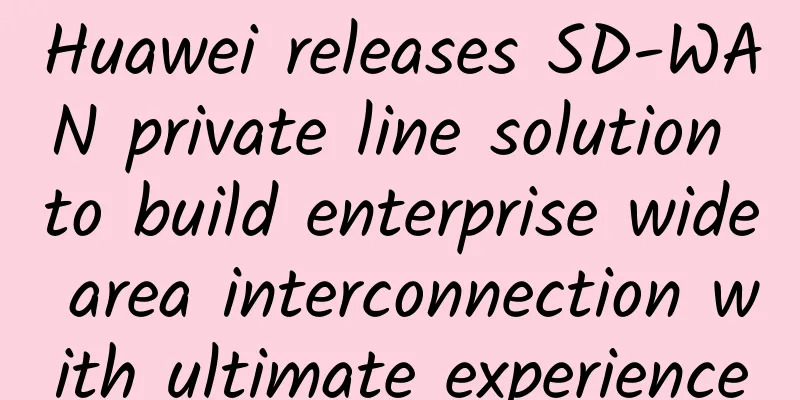From 1G to 5G, the evolution of the era of 5 communication revolutions

|
2019 is seen as the beginning of 5G, and many operators around the world have accelerated their investment in infrastructure to support 5G use cases and services, providing huge potential for users and enterprises. 5G represents a fundamental shift in the role of wireless network technology, evolving from 4G networks and providing advanced technical features such as increased data speeds, reduced latency and improved spectrum efficiency. Telecom operators can leverage the high performance of 5G to provide all their customers with new products and solutions in traditional and non-traditional market segments, thereby generating new sources of revenue and profits. However, the existing mobile network architecture is designed to provide and meet the needs of voice, multimedia and data. The complex interfaces and 3GPP version upgrades have proven that this is an inflexible platform. Understanding how the network is evolving can help us better plan for the present and the future.
The evolution from 1G to 5G The first generation of networks (1G) introduced analog mobile voice services, which established seamless wireless connectivity through licensed spectrum (installation of base stations to provide users with mobile network access through dedicated radio spectrum) and frequency reuse (real-time connection of multiple base stations enables users to have uninterrupted voice calls while on the move). Although 1G was revolutionary, analog transmission had limited capacity in terms of spectrum efficiency and limited scalability using analog equipment (large, expensive, and inefficient). Next came the GSM standard (2G), which evolved from analog to digital transmission and used the TDMA method to achieve more capacity, as well as support roaming between different networks. GSM provided a network platform that supported new mobile services (SMS, MMS, picture messaging) and improved voice quality and clarity through digital coding. Scalability was improved for digital devices, as they were cheaper and lighter than analog devices (digital signals consumed less battery power). GPRS (2.5G) was later introduced to support packet switching technology, which eventually provided data communication services such as WAP, email and World Wide Web access at data rates of 56kbit/s-144kbit/s. After the turn of the millennium, we saw an increase in demand for mobile data services (gaming, video conferencing, large emails, videos), and the third generation (3G) network (implementing UMTS) ushered in a new era of high-speed Internet access with a transmission speed of 2Mbit/s, giving users higher capacity and an enhanced mobile broadband experience. With the growing demand for higher speeds, the fourth generation (4G) network was launched in 2010, aiming to provide a faster and better mobile broadband experience with higher data capacity. Its advantage is simply to improve the bandwidth and services provided by 3G, while improving efficiency by reducing the cost per bit on the network. The advantage of 4G is to provide users with higher data rates (up to 100 Mb/s) by implementing OFDMA technology, supporting wide channels and using signal coding and multiplexing modes. The key difference between 4G and 3G is the implementation of an all-IP network, abandoning the circuit switching infrastructure. Voice services are transmitted over packet-switched networks along with data (voice calls are replaced by IP telephony, i.e. VoLTE). Technical requirements for 5G We are in the early days of the next generation of networks and we will begin to see the global rollout of 5G in 2019-2020, which will be a key enabler for a variety of new and innovative industry services and applications. However, meeting new communication solutions requires meeting a variety of complex technical requirements, and it is important to review the actual technical requirements of 5G compared to previous generations. The “golden triangle” of 5G technology requirements: low latency, connection density, and throughput. 1. Low latency Achieving latency levels below 10 milliseconds will challenge the laws of physics and network layout topologies. Low latency is an essential requirement for business use cases that require instant and ultra-reliable communications, such as remote surgery and autonomous driving. 2. High connection density When it comes to connection density, 5G networks can provide up to one million connections per square kilometer (supporting a large number of concurrent connections to the network) compared to 4G, which has a typical connection density of 2,000 connections per square kilometer. As IoT applications (i.e. smart wearable technology, smart home technology, smart cities, smart grids) become more popular, 5G's high connection density is an important capability to enable massive machine-type communications (M-MTC) use cases and meet the needs of a digital society. 3. High throughput The biggest advantage of the evolution from 3G to 4G is higher throughput, which is also a major factor driving the development of 5G. 5G aims to provide 10 Gbps throughput, enabling enhanced mobile broadband (eMBB) use cases and providing an infrastructure platform for new services such as VR, AR and UHD. Changes in operators’ thinking 1. Spectral efficiency Operators must adopt certain actions, technologies, and business models, including spectral efficiency. Spectrum with larger bandwidths and higher frequencies is needed to provide the capacity required to support a large number of connected devices and to provide higher speeds for simultaneously connected devices. As operators' network capacity begins to run out, improving spectral efficiency is imperative. 5G will be introduced in higher frequency bands, and many operators expect to deploy their 5G systems in the millimeter wave bands. Radio frequency (RF) spectrum is a limited natural resource that supports the continuous development of wireless technologies, systems, and services. As the available amount of RF spectrum in high-density environments becomes saturated, new approaches to spectral efficiency must be considered. MIMO technology uses multiple antennas to transmit carrier signals simultaneously, performing input and output functions within the same spectrum allocation. Beamforming is a technology that focuses the wireless interface into beams for directional signal transmission and reception, improving the overall efficiency of the RF spectrum, which can ultimately improve the user experience. 2. NFV/SDN Operators must also consider their NFV/SDN strategy and how to incorporate it into their core and BSS/OSS architectures. Network Function Virtualization (NFV) is the migration of physical network functions (PNFs) to virtualized network functions (VNFs) and the cloudification of applications. Enterprises and telecom operators must transform their core network functions (i.e., EPC, IMS, HSS) into virtualized network functions to deploy service applications on cloud-based data centers. Software Defined Networking (SDN) is a load- and demand-based extension of cloud architecture and NFV, performing dynamic configuration of network topology (i.e., directing additional network capacity to where it is needed to maintain the quality of customer experience during peak data consumption) from a software-based centralized control pane. 3. Network Slicing The "all-cloud" strategy will provide a coordinated and unified architecture that can provide higher flexibility on a single software-based network infrastructure, capable of managing various service requirements of virtualized network functions and supporting elastic networks. This function is provided by network slicing, which enables the functions of dedicated and logical function layers (slices) on top of shared physical infrastructure, providing end-to-end virtual networks across multiple domains (access, transport, core). The elastic advantages of network slicing provide telecom operators with the opportunity to divide network resources and host multiple different users, introducing the Network Service/Slice as a Service (NSaaS) business model, which will provide customized end-to-end wireless network services, adapt to and manage 5G applications with different transmission characteristics on a single shared infrastructure. 4. Edge computing Finally, we have to consider edge computing, a technology requirement that is closely tied to connected cars because it functions to process application data closer to the user at the edge of the mobile network, enabling the network to provide ultra-low latency for critical business use cases (i.e., autonomous cars) or an enhanced user experience (i.e., AR/VR). The real winners in the 5G era 5G will not only provide users with higher bandwidth, it will also change the way traditional communication service providers work and give birth to more new industries. Only by quickly accepting this change can we become the real winners in the 5G era. |
>>: How to deal with the new security challenges brought by 5G
Recommend
IPv6 network scale deployment accelerates, with active connections reaching 1.15 billion within the year
The large-scale deployment of IPv6 networks has b...
Why are unlimited data plans dying?
Regardless of whether it was a unified arrangemen...
What is edge computing? Why is it called the gas station in the era of smart IoT?
With the rapid development of the Internet of Thi...
5G-driven digital transformation solutions
[[428116]] 【51CTO.com Quick Translation】 Accordin...
36.2%! H3C leads the Chinese campus switch market
Recently, IDC released the "China Ethernet S...
13 departments: Develop intelligent manufacturing using cloud computing, 5G, big data and other technologies
According to the website of the National Developm...
Qorvo Announces Increased RF Fusion20TM Module Availability
[[390846]] Qorvo, a supplier of RF solutions for ...
SoftShellWeb: $30/year KVM-1GB/20GB/200GB/Taiwan (Taipei)
More than a year ago, the tribe shared informatio...
Wu Hequan, academician of the Chinese Academy of Engineering: 5G technology is very immature and the operating costs are extremely high
According to domestic media reports, on October 1...
5G and edge computing are a perfect match
Enterprise IT leaders have heard a lot about edge...
China Radio and Television faces three major challenges on its 5G journey
Since the Ministry of Industry and Information Te...
How AI and software are driving 5G data center transformation
Today, we are witnessing a huge period of innovat...
Example: How to plan IP addresses for a large-scale monitoring network system?
For monitoring projects, many faults are caused b...
Small functions of wireless routers make your Wi-Fi more useful
Have you just bought a wireless router and you ju...
Sharktech cloud server 35% off annual payment starting at $33, 2G memory/40G hard drive/4TB traffic/multiple computer rooms available
Sharktech, also known as SK or Shark Data Center,...









